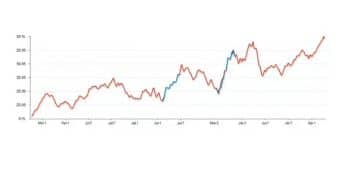Peer-to-peer lending growth: unlocking new opportunities

Peer-to-peer lending is a direct financial model that connects borrowers and lenders through online platforms, offering benefits such as lower interest rates and flexible terms while facing challenges like default risks and regulatory changes.
Peer-to-peer lending growth is transforming how we approach personal finance. Are you curious about how this model can benefit both lenders and borrowers? Let’s dive in!
Understanding peer-to-peer lending
Understanding peer-to-peer lending is crucial in today’s financial landscape. This innovative model connects borrowers directly with investors, cutting out traditional banks. By doing so, it creates a more efficient lending environment.
What is Peer-to-Peer Lending?
Peer-to-peer lending (P2P) is a method where individuals lend and borrow money without the involvement of financial institutions. This model not only streamlines the process but also often leads to lower interest rates for borrowers and better returns for lenders.
How It Works
Typically, a P2P lending platform facilitates the transactions. Borrowers apply for loans, while investors review these applications and choose whom to fund. These platforms use various metrics to assess creditworthiness. This helps in mitigating risks for investors.
- Direct communication between lenders and borrowers.
- User-friendly online platforms.
- Lower fees compared to traditional banks.
- Transparent processes with clear guidelines.
Moreover, P2P lending offers different types of loans to cater to various needs. From personal loans to small business funding, the variety is extensive. This flexibility is appealing to many borrowers.
The growth of peer-to-peer lending platforms has been significant in recent years, with more people recognizing the benefits. With competitive interest rates and a straightforward application process, borrowers find it easier to access funds.
Benefits of Peer-to-Peer Lending
The advantages for both parties are compelling. Borrowers often benefit from more personalized service, while lenders have opportunities to earn higher returns. The innovation has paved the path for a more equitable financial solution.
- Access to a broader range of financial services.
- Opportunities for higher investment returns.
- Increased competition leads to better rates.
- Strengthened community connections through lending.
As peer-to-peer lending continues to evolve, understanding its mechanics is vital. This model could very well redefine personal finance in the future.
The benefits of peer-to-peer lending
The benefits of peer-to-peer lending are becoming increasingly clear as more people explore this innovative financial option. This model connects borrowers directly with lenders, offering unique advantages that traditional banking methods often lack.
Lower Interest Rates
One of the primary attractions of P2P lending is the potential for lower interest rates. Since borrowers are not reliant on traditional banks, they can often receive more favorable terms. Lenders, on the other hand, are often willing to offer better rates to keep their investments competitive.
Flexible Lending Options
Another benefit is the flexibility in loan terms. Unlike banks, which may have strict guidelines, P2P platforms frequently accommodate a variety of borrowing situations. This means that borrowers can find loans tailored to their specific needs.
- Personal loans for diverse purposes.
- Small business loans to fuel growth.
- Short-term loans with quick turnarounds.
- Student loans for educational pursuits.
P2P lending also fosters a sense of community. Investors can directly support individuals or businesses they believe in. This personal connection often leads to a more fulfilling experience for both parties involved.
Additionally, P2P lending platforms typically provide a user-friendly experience. Borrowers can easily apply online, and lenders can review multiple proposals without the lengthy processes associated with traditional lending. This efficiency is another reason why peer-to-peer lending is gaining popularity.
Attractive Returns for Investors
Investors also benefit from the higher potential returns compared to traditional savings accounts. By choosing to lend money on a P2P platform, they can earn interest rates that significantly outperform the average for savings accounts.
- Possibility of substantial profit margins.
- Reduced dependency on volatile stock markets.
- Enhanced portfolio diversification.
- Direct impact on borrowers’ lives.
In summary, the advantages of peer-to-peer lending make it an appealing option for both borrowers and lenders. As this model continues to grow, it may reshape our understanding of finance and personal lending dynamics.
Key factors driving peer-to-peer lending growth

Key factors driving peer-to-peer lending growth reveal how this innovative financial model is changing the lending landscape. Understanding these elements can help both borrowers and lenders take advantage of this new opportunity.
Technological Advancements
One major driver is the rise of technology. P2P lending platforms utilize advanced algorithms to match borrowers with lenders quickly. This speed and efficiency make it easier for individuals to access funds.
Increased Demand for Alternative Financing
As traditional banking systems become more constrained, many people are seeking alternative financing options. This increase in demand drives growth in P2P lending. Borrowers find it appealing to bypass banks and choose more personalized methods of obtaining loans.
- Accessibility for individuals without credit histories.
- Quick application processes that require less paperwork.
- Lower costs for both parties involved.
- Greater transparency in the lending process.
Moreover, the economic environment contributes to the popularity of P2P lending. During financial uncertainty, borrowers look for flexible terms and lower interest rates. This trend has encouraged increased participation in peer-to-peer platforms.
Investor interest is also a key factor in the growth of peer-to-peer lending. Many are attracted by the potential for higher returns compared to traditional savings accounts. This financial incentive further drives funds toward P2P platforms, creating a robust lending ecosystem.
Regulatory Changes
Regulatory changes have played a role in shaping the P2P lending landscape as well. As more countries adapt their laws to facilitate P2P lending, the market expands. Clear guidelines foster trust among users, encouraging wider participation.
- Standardized practices for platform operations.
- Increased consumer protection measures.
- Improved transparency in lending conditions.
- Greater confidence for investors in the P2P ecosystem.
Overall, the combination of technology, demand for alternatives, and regulatory support creates an environment rich for growth in peer-to-peer lending. With these factors at play, P2P lending is set to become increasingly mainstream in personal finance.
Challenges in the peer-to-peer lending market
Challenges in the peer-to-peer lending market are important to consider for both borrowers and investors. Understanding these challenges can help participants navigate the P2P landscape more effectively.
Risk of Default
One major issue is the risk of default. Borrowers may face financial hardships, leading to missed payments. If this happens, lenders could lose their invested amounts. Assessing a borrower’s creditworthiness is vital, but it is not always foolproof.
Market Saturation
Another challenge is market saturation. As more platforms emerge, competition increases. Although this can lower costs for borrowers, it may also dilute the quality of service. Investors might find it harder to identify reliable platforms for lending.
- Increased competition among platforms.
- Potential for decreased interest rates.
- Difficulty for new platforms to establish trust.
- Challenges in ensuring borrower quality.
Moreover, regulatory hurdles can pose significant challenges for P2P lending platforms. In many regions, laws governing these platforms are still evolving. Navigating these regulations can be complex, affecting how platforms operate.
Investor confidence is another important factor. If individuals perceive that the market is too risky, they may hesitate to invest. This can slow down the growth of the peer-to-peer lending industry. To counter these concerns, platforms must work towards building trust and transparency.
Economic Factors
Economic factors also influence the P2P lending market. During economic downturns, defaults may increase, causing concerns for lenders. This volatility can lead to uncertainty and might discourage investment.
- Changing interest rates impacting borrowing costs.
- Economic instability affecting borrower repayment.
- Increased regulation during financial crises.
- Trust issues during economic uncertainty.
By being aware of these challenges, participants in the peer-to-peer lending market can make informed decisions. Addressing these issues head-on is crucial for ensuring the sustainability of P2P lending as a viable financial option.
The future of peer-to-peer lending
The future of peer-to-peer lending looks promising as it continues to evolve in response to changing market dynamics. With a growing number of users recognizing its benefits, P2P lending is expected to reshape the financial landscape.
Technological Innovations
One key element driving this future is technological innovation. Advanced data analytics and artificial intelligence are transforming how lending decisions are made. These technologies can assess credit risk more accurately, ensuring that borrowers are matched with the right lenders.
Expansion of Services
Moreover, as the market grows, P2P platforms are expanding their services. They are likely to offer more diverse loan products, including business loans, home equity loans, and even microloans for startups. This variety will cater to the different needs of consumers and businesses.
- Enhanced borrower verification processes.
- Integration of blockchain technology for security.
- Broader access to funding for underserved communities.
- Flexible lending options tailored to specific needs.
Regulatory frameworks are also expected to evolve, providing greater clarity and security in the P2P lending space. As laws adapt to incorporate P2P lending practices, it will inspire confidence among investors. This growing trust will likely attract more participants to the market.
Another important factor is the environment for investment. As traditional savings options yield lower returns, more individuals are turning to peer-to-peer lending as an attractive alternative. This trend may lead to increased competition among platforms, driving innovation and improving services.
Global Growth Potential
On a global scale, P2P lending is expected to grow significantly. Emerging markets are beginning to adopt this model, providing access to capital for many who previously had no options. This globalization of P2P lending could create new opportunities for both borrowers and investors.
- Expansion into new geographical areas.
- Increased collaboration among platforms worldwide.
- Greater outreach to inform potential users.
- Innovative partnerships with local businesses.
In summary, the future of peer-to-peer lending is bright, marked by innovation, growth, and an evolving landscape that seeks to meet the needs of a diverse audience. As this sector continues to adapt, it will play a vital role in the overall financial ecosystem.
FAQ – Frequently Asked Questions about Peer-to-Peer Lending
What is peer-to-peer lending?
Peer-to-peer lending is a method where individuals lend and borrow money directly from each other through online platforms, bypassing traditional banks.
What are the main benefits of peer-to-peer lending?
The main benefits include lower interest rates, flexible loan terms, and the ability to connect directly with borrowers or lenders.
What risks are involved in peer-to-peer lending?
Risks include the potential for borrower default, market saturation, and fluctuating regulatory environments that can impact operations.
How is the future of peer-to-peer lending expected to evolve?
The future looks bright with technological innovations enhancing credit assessments, a broader range of loan products, and increased global participation.





